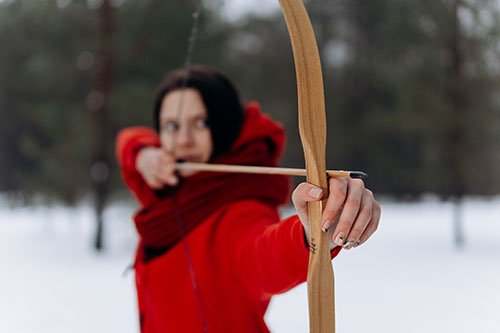How to Properly Measure a Traditional Bow String
May 16th 2023

As a professional bowstring builder, I’ve seen one of the most misunderstood things in archery is how to measure a bow string for a longbow or recurve. This article explains what the industry standards are and why they’re in place.
During the evolution of archery, it soon became apparent that some type of standard needed to be in place so everyone would follow the same guidelines in terms of measuring bow strings.
It seems that the popularity of compounds and crossbows has left some of these older AMO standards to get forgotten in the shuffle. However, with traditional archery still as popular as ever, like using a 66-inch recurve bow, it’s important for shooters and retailers to understand how to properly determine the correct bow string length.
How to Measure a Bow String
The correct way to measure a traditional bowstring (or any bowstring for that matter) is:
- Place it on ¼” pegs at 100lbs of tension for a period of 20 seconds.
- Measure from the outside of the peg to the outside of the peg.
This measurement is the correct bow string length.

At 60X Custom Strings, we’re often asked why we’re measuring a bow string at 100lbs when the bow is only 50lbs? I can understand the confusion, but this is why the industry standard of 100lbs of tension is so important.
Every bow string material on the market has slightly different characteristics. One of these is how much it will stretch. Measuring every string at the standard of 100lbs compensates for the different stretch rates and allows everyone to measure the exact same way, from a 55- to a 66-inch recurve bow and more.
A Dacron bow string, for example, can measure up to 1 inch shorter when hand tightened than it will at the correct tension, while a newer material like 8125 may only have a difference of ¼ inch.
AMO Standards and How to Measure a Bow String Based on Bow Length
AMO specs state that a recurve or longbow should be braced properly with a bowstring that’s 3” shorter (under 100lbs of tension) than the AMO length of that bow. Most traditional bows will be labeled around the grip area with the AMO length. A lot of times, people see the bow stamped with 68” and assume that’s the string length when it’s actually the bow length.
If your longbow or recurve isn’t marked with an AMO length, measure your bow to figure out its length. To do so:
- Lay the bow face down.
- Measure from bow string groove to bow string groove, across the curve of the bow’s limbs.
- Don’t go down into the grip area of the bow but follow the natural line or belly of the bow.
This measurement is the AMO length of the bow. Now, don’t forget to get one 3” shorter. A 66-inch recurve bow would get a 63” string, for example.
A Note About AMO Measurements

Here’s where it can get tricky. I’ve seen several bows that are marked for one length but measure another. This generally means that the bowyer (bow maker) has marked this bow for a specific length so that the correct bow string length will be used.
For example, say you have a bow that measures 57” but is marked “58AMO.” This bow would require a 55” string to achieve the correct brace height (remember, 3” shorter).
This is why it’s important to learn how to correctly measure a bow string yourself or contact the bow maker when it’s time to order a new one. Most bow string manufacturers will be able to compensate for the 100lbs of tension if you tell them what your measured length is with the string hand tight.
Shop 60X Custom Bow Strings
Like everything in archery, there are exceptions to the general guidelines, but the above methods will work most of the time, including for a 66-inch recurve bow. Now that you learned how to measure a bow string, check out our blog for more tips and tricks for all things archery.
As always, if you’re not sure what to order or have any questions, don’t hesitate to contact us at 60x@60xcustomstrings.com or visit our contact page. Don’t forget to subscribe to our newsletter for more help like how-to articles and product reviews.





